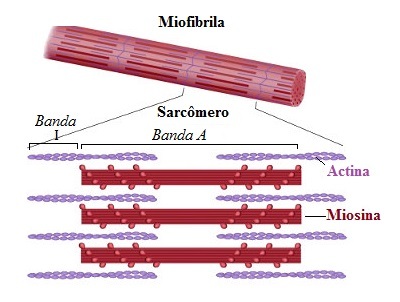You muscles skeletal they are made up of hundreds of elongated cells known as muscle fibers. These fibers are composed of actin and myosin, proteins with the capacity to contract and that form thin and thick filaments, respectively.
The filaments are arranged along the muscle fiber and form light and dark bands. The egg whites are called band I and are formed only by thin filaments. The dark bands are formed by thin and thick filaments and are called band A. The lightest region of this band, where only myosin filaments are found, is called the band H. In the central region of this band, there is also a dark line called the line M.
In the central portion of band I, there is a dark line called Z line that delimits the sarcomere. Each sarcomere is therefore formed by two portions of the I band and an A band.
→ muscle contraction mechanism

For muscle contraction to occur, actin must move over myosin
The muscle contraction mechanism makes the fibers manage to shorten their size. This action is possible thanks to nervous stimuli and the actin and myosin proteins, which slide over each other.
The contraction starts with a stimulus that triggers a release of acetylcholine in the synaptic cleft and causes depolarization of the muscle cell membrane. Then, the opening of Ca channels occurs2+, causing these ions to be released into the cytoplasm by the sarcoplasmic reticulum. At this moment, the interaction of Ca2+ with the myofibrils.
In the presence of Ca2+, the ends of myosin bind with nearby actin molecules and fold with great speed. The actin filament then moves to the center of the sarcomere, triggering the approximation of the two Z lines. This causes the sarcomere to shrink and, to a large extent, leads to contraction of the entire muscle.
When calcium returns to the interior of the sarcoplasmic reticulum, cytoplasmic levels decrease. This causes the muscle to relax and the contraction process is stopped.
By Ma. Vanessa dos Santos
Source: Brazil School - https://brasilescola.uol.com.br/biologia/contracao-musculos-esqueleticos.htm

